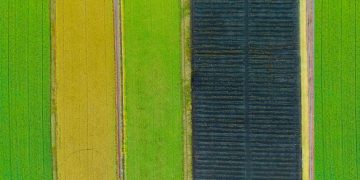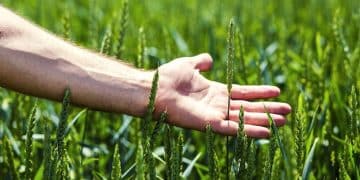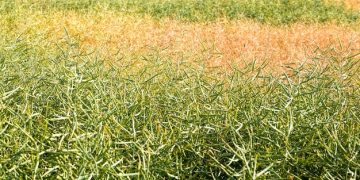Improve Farm Biodiversity: Sustainable Land Management Practices

Improving biodiversity on your farm involves adopting sustainable land management practices such as crop rotation, reduced tillage, cover cropping, integrated pest management, and creating habitats for wildlife, enhancing ecosystem health and resilience.
Looking to boost the biodiversity on your farm? How Can You Improve Biodiversity on Your Farm Through Sustainable Land Management Practices? By implementing practices like conservation tillage and planting diverse cover crops, you can increase the health and resilience of your agricultural ecosystem.
Understanding Biodiversity in Agriculture
Biodiversity, or biological diversity, within an agricultural context refers to the variety of life forms present in and around farmland. This encompasses everything from soil microorganisms and plant species to insects, birds, mammals, and other wildlife. A high level of biodiversity indicates a healthy, resilient ecosystem capable of providing numerous benefits.
Why is biodiversity so vital for farms? It supports essential ecosystem services like pollination, natural pest control, nutrient cycling, and improved soil health. A biodiverse farm is less vulnerable to environmental stresses and more capable of adapting to changing conditions, ensuring long-term productivity and sustainability.

Benefits of Biodiversity on Farms
Enhancing biodiversity on your farm leads to a multitude of advantages. Let’s explore some key benefits:
- Enhanced Pollination: A variety of pollinators, such as bees, butterflies, and other insects, are crucial for the reproduction of many crops. Biodiversity ensures a stable pollinator population.
- Natural Pest Control: Introducing beneficial insects, birds, and other predators can help manage pest populations naturally, reducing the need for chemical pesticides.
- Improved Soil Health: Diverse plant life and soil organisms contribute to nutrient cycling, soil structure, and overall soil fertility.
- Increased Resilience: A biodiverse farm is more resistant to diseases, pests, and climate change impacts, providing greater stability and productivity.
Biodiversity also contributes to the aesthetic value of the farm, making it a more pleasant and attractive place to work and visit. By embracing biodiversity, farmers can create ecosystems that are both productive and sustainable.
Implementing Conservation Tillage
Conservation tillage is a cornerstone of sustainable land management. Unlike conventional tillage, which involves intensive plowing and soil disturbance, conservation tillage minimizes soil disruption. This practice preserves soil structure, reduces erosion, and enhances soil health.
By reducing the frequency and intensity of tillage, farmers can create a more stable environment for soil organisms and reduce carbon emissions. This not only benefits the farm but also contributes to broader environmental goals.
Types of Conservation Tillage
There are several types of conservation tillage, each with its own advantages and suitability for different farming systems:
- No-Till Farming: This method involves planting crops directly into the residue of the previous crop, with no soil tillage. It provides maximum soil protection and conserves soil moisture.
- Reduced Tillage: This approach reduces the number of tillage passes and the depth of tillage, leaving more crop residue on the surface.
- Strip-Till Farming: This method involves tilling only narrow strips of soil where seeds will be planted, leaving the remaining soil undisturbed.

Each tillage practice will vary on the land, crop, and budget. Consult local experts to implement the best choice for you.
Embracing Crop Rotation
Crop rotation is a dynamic practice that involves alternating the types of crops planted in a field over time. This technique is pivotal in sustainable land management as it disrupts pest and disease cycles, improves soil fertility, and reduces reliance on synthetic inputs.
By diversifying the crops grown, farmers can create a more balanced and resilient agricultural system that supports both productivity and environmental health.
Benefits of Crop Rotation
Crop rotation offers numerous advantages that extend beyond simply changing crops. Here are some key benefits:
- Pest and Disease Management: Rotating crops disrupts the life cycles of many pests and diseases, reducing their buildup in the soil and on plants.
- Improved Soil Fertility: Different crops have different nutrient needs. Legumes, for example, can fix nitrogen in the soil, reducing the need for nitrogen fertilizers.
- Weed Control: Rotating crops can help suppress weed growth by altering the growing conditions in the field.
- Enhanced Soil Structure: Different root systems can improve soil structure, aeration, and water infiltration.
When designing a crop rotation plan, consider the specific characteristics of your crops, soil, and climate. A well-planned rotation can significantly enhance the long-term health and productivity of your farm.
Incorporating Cover Cropping
Cover cropping involves planting crops primarily to protect and improve the soil, rather than for harvest. These crops are typically planted in the off-season or between cash crops, providing a range of benefits for both the soil and the environment.
Cover crops enrich the earth, reducing erosion and improving biodiversity. This helps create a more sustainable and resilient agricultural system.
Benefits of Cover Crops
Cover crops offer a multitude of advantages that support sustainable farming practices:
- Erosion Control: Cover crops help protect the soil from wind and water erosion, especially during periods when the soil would otherwise be bare.
- Nutrient Management: Some cover crops can scavenge excess nutrients from the soil, preventing nutrient runoff and pollution. Legumes can also fix nitrogen, enriching the soil.
- Weed Suppression: Cover crops can suppress weed growth by competing for resources and releasing allelochemicals.
- Soil Health Improvement: Cover crops add organic matter to the soil, improving soil structure, water infiltration, and microbial activity.
To maximize the benefits of cover cropping, choose species that are well-suited to your climate, soil type, and cropping system. Incorporating them into your farming practices can lead to significant improvements in soil health and overall farm sustainability.
Integrated Pest Management (IPM)
Integrated Pest Management (IPM) is an ecologically based approach to pest control that aims to minimize the use of synthetic pesticides. IPM strategies consider the entire ecosystem, employing a variety of methods to manage pests while protecting beneficial organisms and the environment.
By adopting IPM practices, farmers can reduce their reliance on chemical inputs, promoting a healthier and more biodiverse farm ecosystem.
Key Components of IPM
IPM involves a systematic approach to pest control that includes several key components:
- Monitoring and Identification: Regularly monitor fields to identify pests and assess their populations. Correct identification is crucial for selecting the most effective control methods.
- Prevention: Implement preventive measures such as crop rotation, sanitation, and using resistant crop varieties to minimize pest problems.
- Biological Control: Introduce or enhance populations of natural enemies, such as beneficial insects, to prey on pests.
- Chemical Control (as a Last Resort): Use synthetic pesticides only when necessary and in a targeted manner, selecting products that are least harmful to beneficial organisms and the environment.
Implementing IPM requires a thorough understanding of pest biology and ecology, as well as careful monitoring and decision-making. However, the benefits of reduced pesticide use and a healthier ecosystem make it a worthwhile investment.
Creating Wildlife Habitats
Creating wildlife habitats on your farm is a powerful way to improve biodiversity and enhance the overall ecological health of your land. These habitats provide food, shelter, and breeding grounds for a variety of species, contributing to a more balanced and resilient ecosystem.
By setting aside areas for wildlife, farmers can create an environment where both agriculture and biodiversity can thrive.
Strategies for Creating Wildlife Habitats
There are several strategies farmers can use to establish and maintain wildlife habitats on their land:
- Hedgerows and Windbreaks: Planting rows of trees and shrubs along field edges can provide shelter for birds, insects, and small mammals, while also reducing wind erosion.
- Pollinator Gardens: Establishing gardens with a variety of flowering plants can attract and support pollinators such as bees, butterflies, and hummingbirds.
- Water Features: Ponds, wetlands, and other water features provide essential habitat for amphibians, waterfowl, and other aquatic species.
- Buffer Strips: Creating vegetated buffer strips along waterways can help filter pollutants and provide habitat for wildlife.
When designing wildlife habitats, consider the specific needs of the species you want to attract and the characteristics of your local environment. This thoughtful approach can help create habitats that are both beneficial for biodiversity and compatible with your farming operations.
Incorporating these sustainable land management practices into your farming operations can significantly enhance biodiversity, improve soil health, and create a more resilient and productive agricultural system. By embracing these methods, farmers can contribute to both environmental sustainability and long-term profitability.
| Key Point | Brief Description |
|---|---|
| 🌱 Conservation Tillage | Minimizes soil disturbance, reducing erosion and improving soil health. |
| 🔄 Crop Rotation | Alternates crop types to disrupt pest cycles and improve soil fertility. |
| 🌿 Cover Cropping | Plants crops primarily to protect soil, add nutrients, and suppress weeds. |
| 🦋 Wildlife Habitats | Creates areas for wildlife, enhancing biodiversity and ecological balance. |
Frequently Asked Questions
▼
Biodiversity supports essential ecosystem services such as pollination, natural pest control, and improved soil health, leading to a more resilient and productive farm.
▼
Conservation tillage minimizes soil disturbance, reducing erosion, improving soil structure, and conserving soil moisture, which benefits soil organisms and reduces carbon emissions.
▼
Crop rotation diversifies nutrient demands, disrupting pest and disease cycles, and improving soil structure, making it more resilient to environmental stresses.
▼
Cover crops prevent erosion, manage nutrients, suppress weeds, and add organic matter to the soil, enhancing overall soil health and biodiversity.
▼
You can create habitats by planting hedgerows, establishing pollinator gardens, creating water features, and setting aside buffer strips to support a variety of wildlife species.
Conclusion
Implementing sustainable land management practices is essential for enhancing biodiversity on your farm. By adopting strategies such as conservation tillage, crop rotation, cover cropping, integrated pest management, and creating wildlife habitats, you can foster a thriving ecosystem that supports both environmental sustainability and long-term agricultural productivity.





